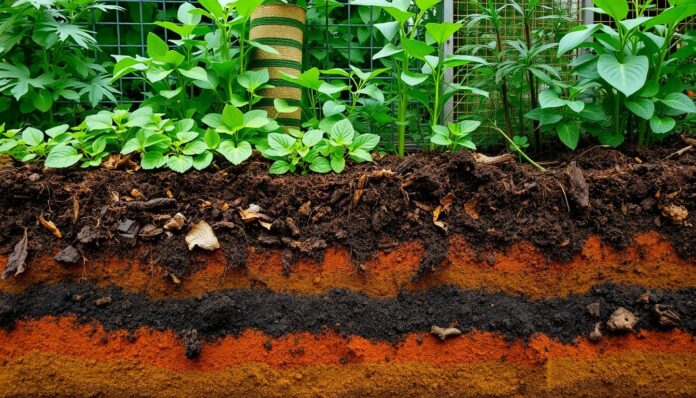What if the key to sustainable agriculture and eco-friendly pest management lay in the earth beneath our feet? Permaculture soil structure is crucial for a healthy ecosystem. By using permaculture techniques, we can make soil healthier and support more biodiversity. Natural and organic methods like composting, mulching, and cover cropping improve soil structure and fertility.
These methods reduce the need for harmful chemicals. For more information on permaculture and sustainable soil tips, visit permaculture sustainable soil tips at https://www.goldhatnursery.com/p/permaculture-sustainable-soil-tips. Learn about the benefits of permaculture practices.
Key Takeaways
- Permaculture practices can improve soil structure and health, increasing nutrient retention by approximately 25% through mulching.
- Cover cropping can lead to a 30% decrease in soil erosion and improve soil fertility by increasing organic matter content by 1-2% annually.
- Composting reduces landfill waste by about 30% and can enhance soil aeration and moisture retention by 50% when used as a soil amendment.
- Mulching with materials like straw, hay, and dried grass clippings improves soil insulation and reduces moisture evaporation.
- Crop rotation helps break pest and disease cycles, potentially increasing crop yields by nearly 15% compared to monoculture systems.
- Permaculture techniques, such as no-dig practices and hugelkultur, can retain up to 80% more moisture compared to conventional soil methods.
- Vermiculture can boost microbial activity in the soil by approximately 30% due to the introduction of nutrient-rich vermicompost.
Understanding Permaculture and Its Principles
Permaculture is a way of living that connects us with nature. It was started in the 1970s and has grown to help people garden in small spaces and on big farms. It’s all about living in harmony with the earth.
Permaculture’s main ideas are to work with nature, save and use energy, and get something back. These ideas help make gardens that are good for the planet and don’t need much help from outside. It also uses mycopesticides and mycelium pesticides to keep pests away without harming the environment.
Definition of Permaculture
Permaculture is guided by three main values: caring for the earth, caring for people, and sharing what we have. It tries to use less and waste less by composting and saving rainwater. This way, we can live in a way that’s better for our planet.
Key Principles of Permaculture
Some important ideas in permaculture are:
- Observe and interact with nature
- Catch and store energy
- Obtain a yield
- Apply self-regulation and accept feedback
- Use and value renewable resources and services
- Produce no waste
By following these principles, permaculture helps us create gardens that are good for the planet. It encourages organic pest control and reduces the need for outside help.
Importance of Soil Structure
Soil structure is key for plant health. It supports growth and development. Healthy soil has 50% clay, sand, humus, and organic materials, and 50% air pockets.
This mix is vital for plant roots to get oxygen and nutrients. The right balance is crucial.
Natural pesticide alternatives and fungal insecticides help in sustainable farming. They reduce harm from chemical pesticides and herbicides. These methods keep soil healthy by preserving living organisms like bacteria and worms.
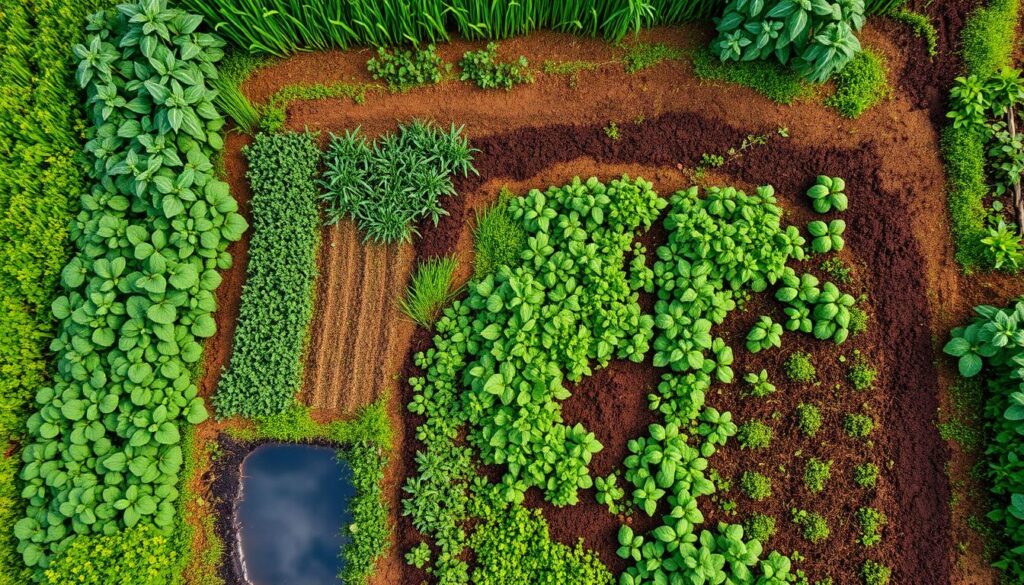
- Improved water infiltration and retention
- Enhanced nutrient cycling and availability
- Increased drought resistance for plants
- Reduced evaporation and erosion
Using organic compost and mulch can improve soil structure. These methods boost biotic activity. By doing this, farmers and gardeners supportsustainable agriculture.
They reduce the environmental impact of farming. This helps create a healthier ecosystem.
Characteristics of Healthy Soil
Healthy soil is key for plants to grow well and for the environment to stay balanced. It has five main parts: living things, dead organic matter, minerals, water, and air. In the best soil, minerals make up about 50%, and organic matter is 0-10%.
Soil’s texture and makeup are very important for its health. Soil can be sandy, silty, or clayey. Mycorrhizal fungi, which work with plant roots, help soil stay healthy. They make it easier for plants to get nutrients. Using eco-friendly ways to manage pests, like permaculture, also helps keep soil healthy.
Healthy soil has a few important features:
- It holds and drains water well.
- It has enough nutrients for plants.
- It has the right mix of sand, silt, and clay.
- It’s full of life, including mycorrhizal fungi.
Knowing what makes soil healthy and using eco-friendly methods like permaculture helps. We can make a better ecosystem. This supports plant growth and keeps our environment healthy.
| Soil Component | Percentage of Soil Composition |
|---|---|
| Minerals | 50% |
| Organic Matter | 0-10% |
| Water | 25% |
| Air | 25% |
Assessing Soil Structure in Your Garden
Checking soil structure is key for healthy soil and green farming. By looking at the soil’s texture and makeup, gardeners can spot what needs fixing. Using permaculture mycopesticides helps control pests without harming the soil.
Bad soil signs include hard water absorption, poor air, and stunted roots. Gardeners can use simple tools like a soil probe or shovel to check the soil. They can also do tests like the infiltration test or earthworm test to see how the soil is doing.
Important things to think about when checking soil include:
- Soil texture and makeup
- How well water soaks in and drains
- Life in the soil, like earthworms and tiny bugs
- How well roots grow
Using organic pest control and green farming helps improve soil. Techniques like permaculture mycopesticides, planting cover crops, and rotating crops are good. These methods help create a healthy garden ecosystem that supports plants and is good for the environment.
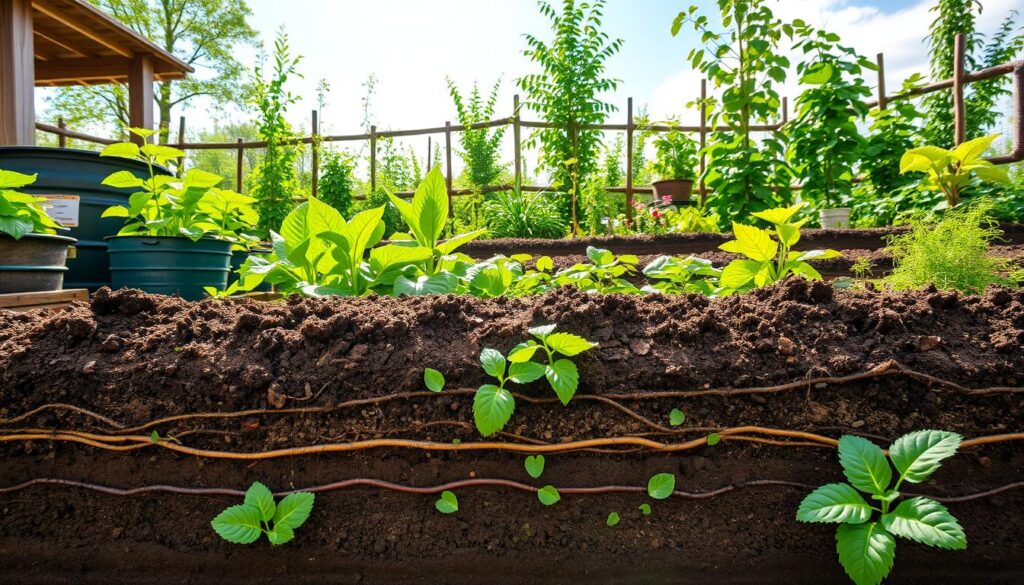
| Soil Test | Purpose | Method |
|---|---|---|
| Infiltration Test | Evaluate water infiltration | Measure water infiltration rate |
| Earthworm Test | Assess biological activity | Count earthworms in a soil sample |
Techniques to Improve Soil Structure
Improving soil structure is key for plant health and growth. No-till gardening and cover cropping are two effective methods. No-till gardening keeps soil biota alive. Cover cropping boosts nutrient availability and retention.
Mycelium pesticides and fungal insecticides are natural alternatives to synthetic pesticides. They help control pests and improve soil health. These methods reduce the need for harmful chemicals.
Using mycelium pesticides and fungal insecticides promotes a healthier soil ecosystem. They target pests without harming beneficial organisms. This creates a balanced and resilient soil environment.
No-Till Gardening
No-till gardening minimizes soil disturbance. It preserves the soil’s natural structure and biota. This method reduces erosion, increases moisture, and supports root growth.
By adopting no-till gardening, gardeners foster soil health and plant growth. It creates an ideal environment for plants.
Cover Cropping Practices
Cover cropping involves planting crops between cycles to improve soil health. These crops add organic matter, increase nutrients, and reduce erosion. Cover crops enhance soil structure, reduce synthetic fertilizer needs, and promote ecosystem health.
Benefits of cover cropping include:
- Improved soil structure and fertility
- Increased moisture retention and reduced erosion
- Enhanced nutrient availability and reduced need for synthetic fertilizers
- Promotion of healthy soil biota and ecosystem balance
By using natural pesticide alternatives like mycelium pesticides and fungal insecticides in cover cropping, gardeners can manage soil comprehensively. This approach supports soil health, reduces environmental impact, and aids plant growth.
The Role of Organic Matter in Soil
Organic matter is key to keeping permaculture soil healthy. It includes things like decomposing leaves and compost. These materials help the soil hold nutrients and stay structured.
Every gram of topsoil is home to billions of microorganisms. They need organic matter to survive.
Soil organic matter makes up about 1.7-1.9% of the soil. Yet, it greatly affects how much water the soil can hold. It can hold up to 35-40,000 gallons of water per acre.
Organic matter also helps create humus. Humus is a stable organic matter that makes the soil better at holding water and air.
The benefits of organic matter in soil are many. Some of the main advantages include:
- Improved water retention: Organic matter can hold up to 20 times its weight in water.
- Enhanced soil structure: It can reduce soil erosion by up to 50% by making the soil more stable.
- Increased soil fertility: Adding compost once a year can increase soil fertility by 10-30%.
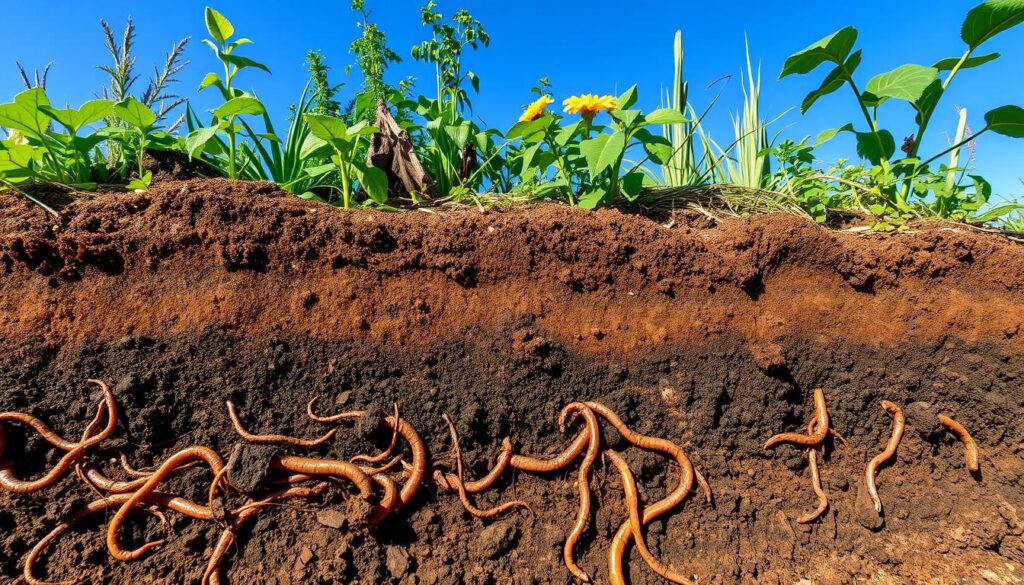
By using sustainable agriculture, like adding compost, we can improve soil health. This not only helps the environment but also makes our food system more sustainable.
| Soil Organic Matter Level | Water-Holding Capacity |
|---|---|
| 1.7-1.9% | 35-40,000 gallons per acre |
Utilizing Soil Microorganisms
Soil microorganisms, like mycorrhizal fungi and bacteria, are key to keeping soil healthy. They help plants grow by forming special bonds with roots. This natural method can replace harmful chemicals, making farming safer for the planet.
Using mycorrhizal fungi in farming can make soil better and more fertile. This leads to stronger, healthier crops. It’s a big step towards farming that’s good for the environment and supports nature’s balance. Some main advantages of using mycorrhizal fungi include:
- Improved nutrient uptake and plant growth
- Enhanced soil structure and fertility
- Increased resistance to pests and diseases
By choosing sustainable farming that uses soil microorganisms, farmers help the environment. This method not only protects nature but also keeps soil rich and productive for a long time.
The Importance of Drainage
Good drainage is key for healthy permaculture soil. Waterlogged soil can cut crop yields by a lot, hurting farm productivity. Farmers can boost yields by 10-15% with sub-irrigation, as seen in eastern Canada.
Soils with lots of clay can get waterlogged. Farmers need to check the soil’s pH, organic matter, and how well it drains. Techniques like keyline design help improve soil faster than usual methods.
Plants like willow and cattails help lower the water table. Shallow-rooted plants like clover and thyme stop water from pooling on the surface. This keeps the soil stable.
Using eco-friendly pest control and sustainable farming can also make soil healthier. Cover crops can cut down soil erosion and boost soil health, depending on the climate. These practices help create a balanced ecosystem for permaculture soil.
Farmers can also use rain gardens to improve drainage. Rain gardens can remove up to 90% of pollutants from rainwater. They should cover about 20% of the drainage area, with a slope to direct water to the center.
| Soil Type | Drainage Capacity |
|---|---|
| Clay | Low |
| Silt | Medium |
| Sand | High |
Understanding soil drainage needs and using the right techniques can make permaculture soil healthy and sustainable. This supports eco-friendly pest control and sustainable farming.
Crop Rotation and Soil Structure
Crop rotation is key in permaculture for better soil health. It helps avoid nutrient depletion and cuts down on synthetic fertilizers. This method also breaks disease and pest cycles, which can lower the need for organic pest control.
Crop rotation offers many advantages. It boosts crop yields and soil organic matter. It also increases biodiversity. Natural pesticide alternatives can be used alongside it to reduce chemical pesticide use. For instance, marigolds and nasturtiums repel pests, while comfrey and clover act as natural fertilizers.
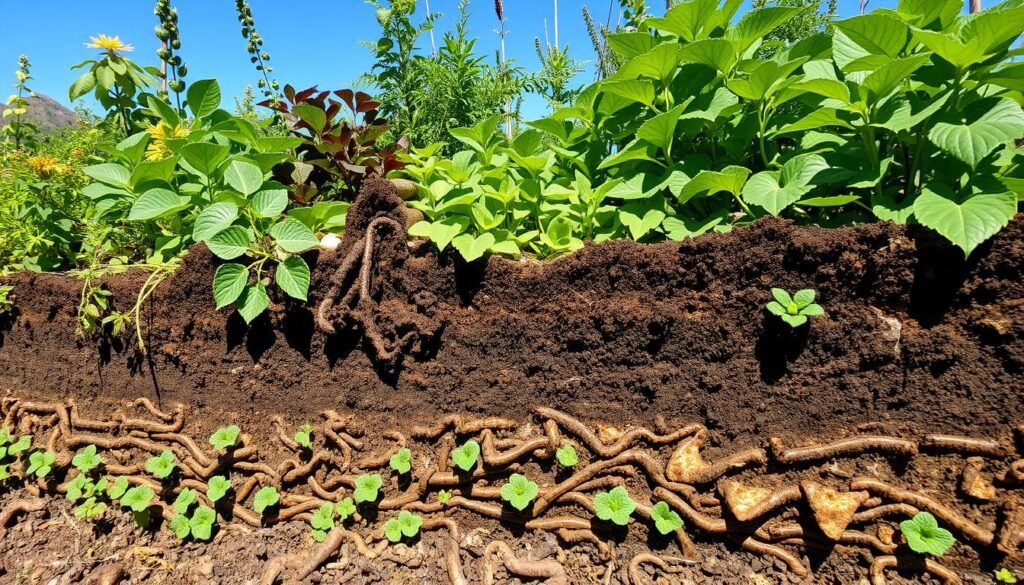
The main benefits of crop rotation are:
* Better soil fertility and structure
* Higher crop yields
* More biodiversity
* Less need for artificial fertilizers and pesticides
* Healthier soil organic matter
By using permaculture mycopesticides and other natural pesticide alternatives in their rotation, farmers can make their farming more sustainable and strong.
Creating Contour Beds
Contour beds are a key part of sustainable agriculture. They help manage water and protect the soil. Gardeners can use them to fight pests in an eco-friendly way. Mycorrhizal fungi also help improve the soil in these beds.
Some benefits of contour gardening include:
- Improved water retention and reduced runoff
- Increased soil fertility and structure
- Enhanced biodiversity and ecosystem health
To build contour beds, follow these steps:
- Assess the site and find the best spot for the bed
- Design the bed to catch and hold rainwater
- Use compost and mulch to make the soil better
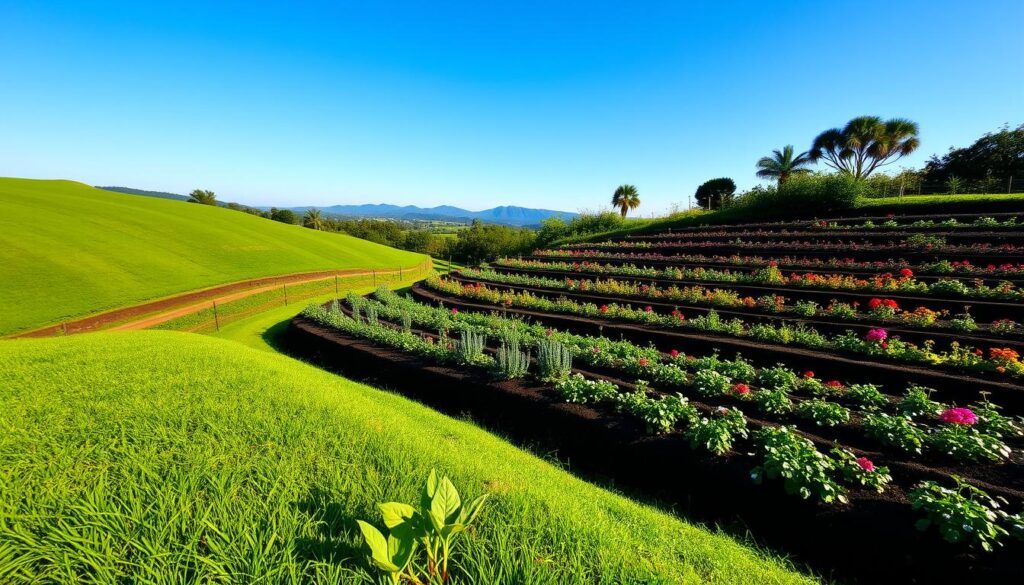
By using mycorrhizal fungi and sustainable practices, gardeners can make a strong ecosystem. Eco-friendly pest management helps keep the soil healthy. This way, we can avoid harmful chemicals and keep the balance right.
| Technique | Benefits |
|---|---|
| Contour gardening | Improved water retention, increased soil fertility, and enhanced biodiversity |
| Mycorrhizal fungi | Improved soil health and structure, increased nutrient uptake, and enhanced plant growth |
| Eco-friendly pest management | Minimized use of chemical pesticides, maintained balance of beneficial organisms, and reduced environmental impact |
Using Guilds to Enhance Soil Structure
Permaculture guilds are vital for sustainable farming. They boost growth, improve soil health, and increase biodiversity. By planting different species together, gardeners create a thriving ecosystem. This ecosystem needs fewer pesticides and promotes healthy soil.
Planting Companion Species
Companion planting is a key part of permaculture. It involves planting different species together to improve soil health and reduce pesticide use. For instance, the “Three Sisters” guild includes corn, beans, and squash. These plants work together to make the soil more fertile and structured.
Nitrogen-fixing plants like clover and peas also help. They make the soil richer, cutting down the need for synthetic fertilizers.
The Power of Biodiversity
Permaculture guilds can include many plants working together. This diversity makes the ecosystem strong and healthy. It also boosts biodiversity and supports sustainable farming.
By using guilds and companion planting, gardeners can make their permaculture systems thrive. These systems need fewer pesticides and promote healthy soil.
- Improved soil fertility and structure
- Increased biodiversity and ecosystem resilience
- Reduced need for synthetic fertilizers and pesticides
- Enhanced crop yields and overall system productivity
By adding guilds and companion planting to their permaculture, gardeners can create a sustainable ecosystem. This ecosystem promotes healthy soil and reduces pesticide use.
Water Management and Soil Structure
Keeping soil healthy is key, and water management plays a big role. Using mycelium pesticides and fungal insecticides helps. These methods not only save water but also make the soil better at holding moisture, up to 20% more.
Some important ways to keep water in the soil include:
- Mulching to cut down on water loss by 30-50%
- Passive water capture to use up to 60% more rainwater
- Companion planting to save about 25% more water
Organic mulch helps keep the soil moist and adds nitrogen as it breaks down. These green practices help farmers use less commercial fertilizers and pesticides. This makes farming more sustainable.
| Technique | Water Savings |
|---|---|
| Mulching | 30-50% |
| Passive water capture | up to 60% |
| Companion planting | 25% more water |
By using these water-saving methods and mycelium pesticides and fungal insecticides, farmers can improve soil health. This reduces erosion and supports sustainable farming.
The Influence of Climate on Soil Structure
Climate greatly affects the structure of permaculture soil. Factors like regional climate and seasonal changes are key. Using natural pesticides helps protect soil from climate damage.
In wet areas, soil can become waterlogged. This leads to poor drainage and air. Dry regions face soil erosion and nutrient loss. Permaculture helps farmers build strong soil that can handle these issues.
Improving soil in various climates involves several steps:
- Using cover crops to reduce erosion and add organic matter
- Implementing conservation tillage to lessen soil disturbance
- Applying natural pesticide alternatives to cut down chemical use
Understanding climate’s impact on soil and using sustainable methods can improve soil health. This leads to better crops, more biodiversity, and stronger ecosystems.
| Climate Region | Soil Structure Challenges | Sustainable Agriculture Strategies |
|---|---|---|
| Tropical | High rainfall, soil erosion | Conservation tillage, cover crops |
| Temperate | Soil compaction, nutrient depletion | Reduced tillage, natural pesticide alternatives |
| Arid | Soil salinization, water scarcity | Drought-resistant crops, efficient irrigation systems |
Incorporating Agroforestry Practices
Agroforestry systems can boost farm productivity by 20-30% over traditional farming. This method mixes farming and forestry, leading to sustainable agriculture. It improves soil health and boosts biodiversity. Trees in farming systems help the soil, make nutrients more available, and support mycorrhizal fungi.
Agroforestry is great for eco-friendly pest management. It creates a diverse ecosystem, reducing the need for harmful pesticides. This can cut pest outbreaks by 70%, as diverse systems need less chemical use.
- Improved soil health and structure
- Increased biodiversity and ecosystem services
- Enhanced sustainable agriculture practices
- Promotion of eco-friendly pest management techniques
- Support for beneficial microorganisms like mycorrhizal fungi
For more on improving soil with agroforestry and permaculture, check sustainableliving.org.nz. These methods help farmers support a greener, more secure food system.
Long-Term Maintenance of Soil Structure
Regular soil testing is key for keeping permaculture soil structure healthy. It helps check nutrient levels, pH, and microbial activity. This way, farmers can spot and fix any issues.
By using sustainable agriculture methods, like crop rotation and organic amendments, farmers can cut down on synthetic fertilizers and pesticides. This helps create a more balanced ecosystem.
It’s also important to adapt farming practices for sustainability. This means using natural pesticide alternatives, like introducing beneficial insects or plant-based pest control. These methods help farmers reduce their environmental impact while keeping the soil healthy.
- Adding organic matter, such as compost or manure, to improve soil structure and fertility
- Using cover crops to reduce erosion and promote soil biota
- Implementing conservation tillage or no-till practices to minimize soil disturbance
By choosing these sustainable practices, farmers can improve permaculture soil structure. They also reduce their environmental footprint and help make the food system more resilient.
| Soil Health Indicator | Improved Soil | Depleted Soil |
|---|---|---|
| Water Retention | 25% greater capacity | Reduced capacity |
| Soil Erosion | 90% reduction in risk | Increased risk |
| Fertilizer Requirements | Up to 50% reduction | Increased requirements |
Conclusion: Committing to Soil Health
The future of permaculture is bright because it improves soil health and supports sustainable living. Using
permaculture mycopesticides
and
mycelium pesticides
can change the game in managing pests. This helps our soils stay healthy.
Future of Soil and Permaculture
The Permaculture Association dreams of a world where communities live in harmony with nature. This shows their dedication to sustainable living. By following permaculture’s principles, we can make our soils strong and productive. This benefits both our environment and the food we grow.
Encouragement for Sustainable Practices
There’s a lot of hope for those ready to improve soil health and adopt
eco-friendly pest management
. You can make a big difference by using
permaculture mycopesticides
, practicing no-till gardening, or adding cover crops. Every action counts. By sticking to these practices, we can keep our soils healthy for the future. This will lead to a more abundant and strong world.

